I have a web application which converts some PCL files to PDF by running a scheduler task every 10 seconds. Each time it takes max. 20 pc files from a directory and convert them to pdf.
First few tasks run nice but step by step it gets slower and suddenly a GC overhead limit exceeded error message is raised.
I've tried to analyze this memory leak with VisualVM and here is some output from the heapdump:
It's strange that such amount of bytes instances (3.366.687 !!!) it's shown. In the application I also have Streams and I really checked to see if all this streams are closed when their related operations are done.
I use byte in a single class in three methods : byte[] buf = new byte[1024];
public void initBuf() {
if (buf != null) {
for (int i = 0; i < buf.length; i++) {
buf[i] = (byte) 0x00;
}
pdf_y = PageSize.A4.getHeight();
}
}
public void appendBuf(char ch) {
if (ch == '\n') {
processChunk();
drawChunks();
pdf_newline();
} else if (ch != '\r') {
buf[buf_index++] = (byte) (0xff & ch);
}
}
public void resetBuf() {
for (int i = buf_index; i >= 0; i--) {
buf[i] = (byte) 0x00;
}
buf_index = 0;
}
Where would you advice me to look? How can I really identify which of my code is doing this harmfull?
I cannot post all the code because there are more classes which do this conversion but I really hope you to help me with some advices becauise I spent a lot of time and still this memory issue persists.
Thanks in advance